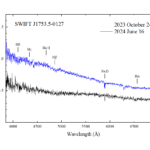ATel #16660: The optical spectrum of the black hole transient SWIFT J1753.5-0127 remains featureless
ATel #16660 (18 Jun 2024): V. V. Neustroev (University of Oulu)
Here we report new optical, UV, and X-ray observations acquired with the Nordic Optical Telescope (NOT) and the UVOT and XRT instruments of NASA’s Neil Gehrels Swift observatory.
The black hole X-ray binary SWIFT J1753.5-0127 entered the second known optical outburst on 2023 September 28 (ATel #16262). In a few days, an optical flux of the transient reached a level, similar to its previous outburst (V~16.75, ATel #16314, #16318). It remained approximately constant until the end of the visibility period due to the Sun constraint (the end of October 2023). The first optical spectra of the source, obtained in the new outburst on October 24 and 25, show a blue continuum with no spectral lines, except for telluric and interstellar absorption lines (ATel #16314).
The first observations after the Sun constraint, performed at the end of January and the beginning of February of 2024, showed that SWIFT J1753.5-0127 is already heading towards quiescence (ATel #16427, #16447). The optical observations acquired on March 8 with the Las Cumbres Observatory network found the transient at r’ = 21.57 +/- 0.18 (ATel #16527). However, the following optical monitoring has shown that the source re-brightened once again, reaching V = 18.28 +/- 0.02 on March 27 (ATel #16559).
Since then, the source has been observed multiple times by NASA’s Neil Gehrels Swift observatory with the XRT and UVOT instruments. According to the UVOT observations, SWIFT J1753.5-0127 has been quite stable at the average magnitude of uvw2 = 17.75 +/- 0.14 (the error is the RMS deviation of the measured magnitudes). This is about a half-magnitude dimmer than during the plateau stage before the Sun constraint (uvw2 = 17.30 +/- 0.12). The Swift/XRT observations showed that a count rate in the 0.3-10.0 keV energy range had been steadily rising from 0.26 +/- 0.02 cts/s on April 7 up to 1.30 +/- 0.08 cts/s on May 4. After that, it started declining and reached a level of 0.50 +/- 0.06 cts/s on June 14.
We observed SWIFT J1753.5-0127 on June 16 with the NOT/ALFOSC imager and spectrograph. We acquired multicolour photometric data and obtained the following magnitudes:
u’=17.62 +/- 0.06, g’=17.47 +/- 0.03, r’=17.16 +/- 0.02, i’=16.92 +/- 0.02, z’=16.82 +/- 0.02.
We note that during the previous outburst started in 2005, SWIFT J1753.5-0127 showed a rather featureless optical spectrum most of the time until 2013 when the object slightly declined and the broad emission lines emerged (ATel #5307; Neustroev et al. 2014, MNRAS, 445, 2424). Now the object has an optical flux lower by about 30 per cent than in 2013. Attempting to detect emission lines, we obtained 3 spectra with a total exposure time of 30 mins, using grism #7 and a slit width of 1 arcsecond which provide a spectral resolution of R~650 in the spectral range 3650-7110 Angstrom.
We find that the optical spectrum of the transient remains featureless.
- The average spectrum of Swift J1753.5-0127
See also ATel #16314 & #16427.
This entry was posted on Tuesday, June 18th, 2024 at 21:47 and is filed under Astronomy, Observations, Publications, Work. You can follow any responses to this entry through the RSS 2.0 feed. Both comments and pings are currently closed.

